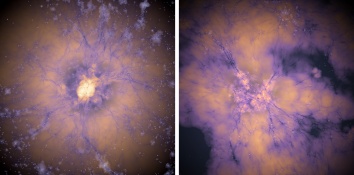A new study by physicists at MIT and The University of Texas at Austin tackles two of the biggest puzzles in cosmology. They are the Hubble tension, which refers to a mismatch in measurements of how fast the universe is expanding; and observations of numerous early, bright galaxies at a time when the early universe should have been much less populated.
The team has found that both puzzles could be resolved if the early universe had one extra, fleeting ingredient: early dark energy. Dark energy is an unknown form of energy that physicists suspect is driving the expansion of the universe today. Early dark energy is a similar, hypothesized phenomenon that may have had only a brief appearance, influencing the expansion of the universe at much earlier times before disappearing entirely.
“You have these two looming open-ended puzzles,” said study co-author Rohan Naidu, a postdoc in MIT’s Kavli Institute for Astrophysics and Space Research. “We find that, in fact, early dark energy is a very elegant and sparse solution to two of the most pressing problems in cosmology.”
The study was published today in the Monthly Notices of the Royal Astronomical Society.
Puzzle One: The Hubble Tension
The Hubble tension is a discrepancy between two different methods of measuring the expansion rate of the universe, known as the Hubble constant. One method observes nearby astronomical objects to calculate this rate. The other uses observations of the early universe to infer what the Hubble constant should be. In theory, the methods should come to the same result. But they don’t.
Early dark matter could be a solution to this problem. As a sort of anti-gravitational force that turns on briefly a few thousand years after the Big Bang, it would accelerate the early expansion of the universe enough to resolve the mismatch in measurements. “Early dark energy is one possible addition to the standard cosmological model that would preserve its many successes and resolve the Hubble tension,” said study co-author Michael Boylan-Kolchin, a professor of astronomy at The University of Texas at Austin.
Puzzle Two: Bright Early Galaxies
The researchers have also proposed that early dark energy could explain the baffling number of bright galaxies that astronomers have observed in the early universe. Based on the standard cosmological and galaxy formation models today, the universe should have taken its time in spinning up the first galaxies. It would have taken billions of years for primordial gas to coalesce into galaxies as large and bright as the Milky Way.
But in 2023, NASA’s James Webb Space Telescope (JWST) made a startling observation. With an ability to peer farther back in time than any observatory to date, the telescope uncovered a surprising number of bright galaxies as large as the modern Milky Way within the first 500 million years, when the universe was just 3 percent of its current age.
“The bright galaxies that JWST saw would be like seeing a clustering of lights around big cities, whereas theory predicts something like the light around more rural settings like Yellowstone National Park,” said Xuejian (Jacob) Shen, lead author of the study and a Kavli postdoc at MIT. “And we don’t expect that clustering of light so early on.”
The observations imply that either there is something fundamentally wrong with the physics underlying the models, or there is a missing ingredient in the early universe that scientists have not accounted for. The team explored whether early dark energy could be that missing ingredient.
Models of early galaxy formation typically do not account for the possibility of early dark energy. If it were present, they would need to adjust some of the other “cosmological parameters.” These are the basic ingredients responsible for the evolution of the universe - things like Hubble’s constant, the amount of dark matter present, and how dense the universe was right after the Big Bang.
The team created their own model of early galaxy formation that included early dark energy. Specifically, early dark energy with the same conditions needed to resolve the Hubble tension. They found that the number of early galaxies created by this scenario fit the number of those observed in the early universe.
“The fact that one model can explain these two unrelated issues makes it intriguing and worth pursuing in more detail,” said Boylan-Kolchin. “By getting more data with JWST and studying the oldest light in the universe in more detail, we should actually know if early dark energy is the right answer within the next year or so, which is really exciting.”
Acknowledgements
The study’s co-authors include lead author and MIT Kavli postdoc Xuejian (Jacob) Shen and MIT professor of physics Mark Vogelsberger, along with Samuel T. and Fern Yanagisawa Regents Professor Michael Boylan-Kolchin at The University of Texas at Austin, Sandro Tacchella at the University of Cambridge, and Rohan Naidu at MIT.
Research was supported in part by NASA and the National Science Foundation.
Based on a press release by Jennifer Chu, MIT News.






